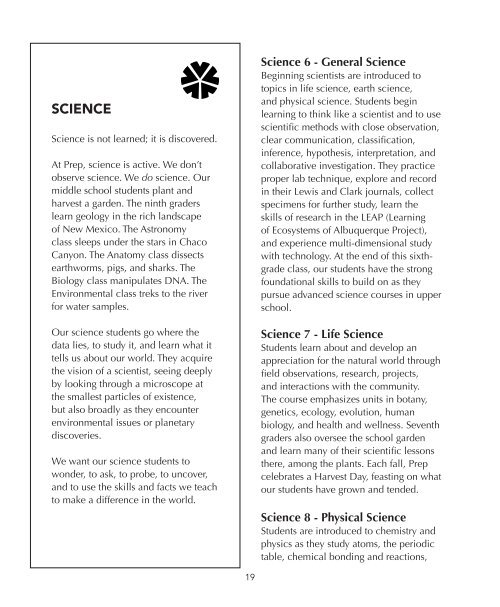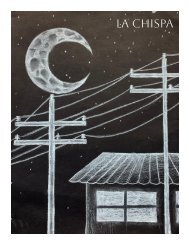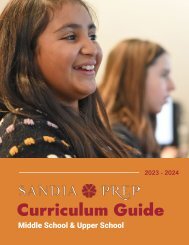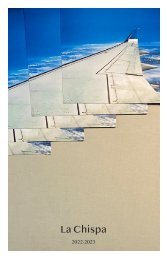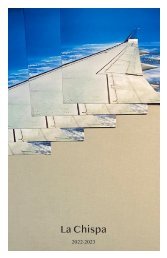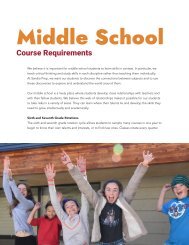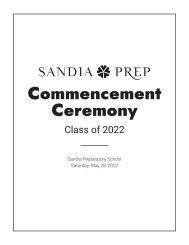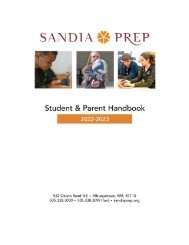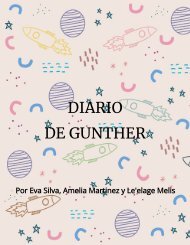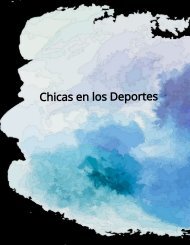Sandia Prep - Curriculum Guide: 2016-2017
Sandia Preparatory School's Middle & Upper School Curriculum Guide: 2016-2017
Sandia Preparatory School's Middle & Upper School Curriculum Guide: 2016-2017
Create successful ePaper yourself
Turn your PDF publications into a flip-book with our unique Google optimized e-Paper software.
SCIENCE<br />
Science is not learned; it is discovered.<br />
At <strong>Prep</strong>, science is active. We don’t<br />
observe science. We do science. Our<br />
middle school students plant and<br />
harvest a garden. The ninth graders<br />
learn geology in the rich landscape<br />
of New Mexico. The Astronomy<br />
class sleeps under the stars in Chaco<br />
Canyon. The Anatomy class dissects<br />
earthworms, pigs, and sharks. The<br />
Biology class manipulates DNA. The<br />
Environmental class treks to the river<br />
for water samples.<br />
Our science students go where the<br />
data lies, to study it, and learn what it<br />
tells us about our world. They acquire<br />
the vision of a scientist, seeing deeply<br />
by looking through a microscope at<br />
the smallest particles of existence,<br />
but also broadly as they encounter<br />
environmental issues or planetary<br />
discoveries.<br />
We want our science students to<br />
wonder, to ask, to probe, to uncover,<br />
and to use the skills and facts we teach<br />
to make a difference in the world.<br />
19<br />
Science 6 - General Science<br />
Beginning scientists are introduced to<br />
topics in life science, earth science,<br />
and physical science. Students begin<br />
learning to think like a scientist and to use<br />
scientific methods with close observation,<br />
clear communication, classification,<br />
inference, hypothesis, interpretation, and<br />
collaborative investigation. They practice<br />
proper lab technique, explore and record<br />
in their Lewis and Clark journals, collect<br />
specimens for further study, learn the<br />
skills of research in the LEAP (Learning<br />
of Ecosystems of Albuquerque Project),<br />
and experience multi-dimensional study<br />
with technology. At the end of this sixthgrade<br />
class, our students have the strong<br />
foundational skills to build on as they<br />
pursue advanced science courses in upper<br />
school.<br />
Science 7 - Life Science<br />
Students learn about and develop an<br />
appreciation for the natural world through<br />
field observations, research, projects,<br />
and interactions with the community.<br />
The course emphasizes units in botany,<br />
genetics, ecology, evolution, human<br />
biology, and health and wellness. Seventh<br />
graders also oversee the school garden<br />
and learn many of their scientific lessons<br />
there, among the plants. Each fall, <strong>Prep</strong><br />
celebrates a Harvest Day, feasting on what<br />
our students have grown and tended.<br />
Science 8 - Physical Science<br />
Students are introduced to chemistry and<br />
physics as they study atoms, the periodic<br />
table, chemical bonding and reactions,<br />
radioactivity, mechanical forces, energy,<br />
sound, and light. This course involves<br />
lab work and the further development<br />
of problem solving skills. At the end of<br />
the year, students have familiarity with<br />
skills and topics necessary for success<br />
in our challenging upper school science<br />
curriculum.<br />
Geology<br />
Grade 9<br />
It would be unforgivable not to teach<br />
Geology in New Mexico. Our climatic<br />
conditions act to both expose and preserve<br />
fine examples of the forces and materials<br />
which have formed not only our state,<br />
but our planet. Our students, as do many<br />
scientists from around the world, visit and<br />
investigate volcanoes at the Rio Grande<br />
Rift (the third largest rift in the world), and<br />
the Ojito Wilderness. They travel through<br />
geologic time, studying sediment and rock<br />
formations, and investigate the world of<br />
paleontology. Knowledge of minerals,<br />
fuels, and natural resources allow students<br />
to understand the delicate relationship<br />
between humans and the earth, the causes<br />
and consequences of catastrophic geologic<br />
events, and the history of humanity.<br />
Advanced Geology<br />
Grades 11-12<br />
Prerequisite: Geology 1 with a grade of<br />
“B-” or better and/or permission of the<br />
instructor, Algebra 2.<br />
In Advanced Geology, students study New<br />
Mexico geology using the Rio Grande rift<br />
as a field study area to learn about local<br />
rock formations, history of environments of<br />
deposition, and the structural history of this<br />
20<br />
area. This leads to interpretive studies and<br />
problem solving in structural geology and<br />
stratigraphy. These areas will be correlated<br />
with laboratory work using satellite<br />
imagery, topographic maps, and geologic<br />
maps. Field investigations include mapping<br />
of various structures and rock types. During<br />
the second semester, students take an<br />
in-depth look at various research topics<br />
including historical geology; paleontology<br />
– the study of fossils in the geologic<br />
record; and geologic resources and their<br />
environmental, global, and economic<br />
impact.<br />
Molecular Biology<br />
Grade 10<br />
<strong>Prep</strong>’s Biology courses emphasis hands-on<br />
laboratory work, such as enzyme reactions<br />
on hydrogen peroxide, cell respiration<br />
and fermentation, cell mitosis, and the<br />
difference in electrical conductivity<br />
between organic and inorganic<br />
compounds. Students learn the basics<br />
of biology, while concentrating on the<br />
biochemical perspective such as molecular<br />
structure, microscopy, cellular structures<br />
and processes, and heredity.<br />
Ecological Biology<br />
Grade 10<br />
Through close study of ecological systems,<br />
this course leads students to an expanded<br />
vision of the earth, its inhabitants, and<br />
survival. Using scientific methods of data<br />
gathering and interpretation, students<br />
consider not only current systems of<br />
diverse life forms, but they also look<br />
ahead to anticipate the consequences of<br />
environmental changes and decisions.


